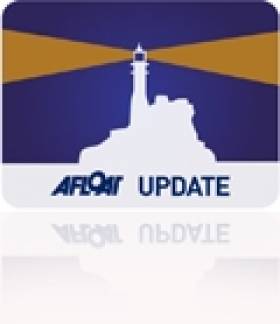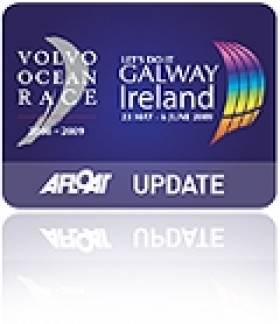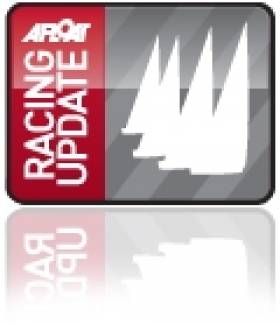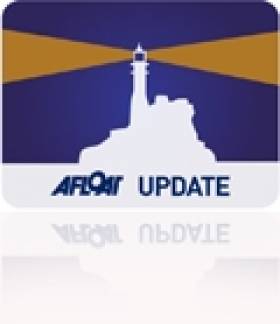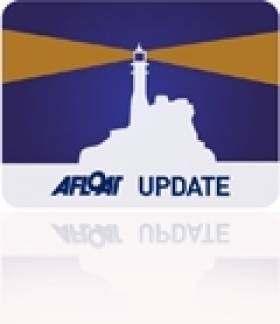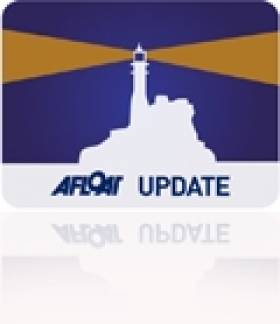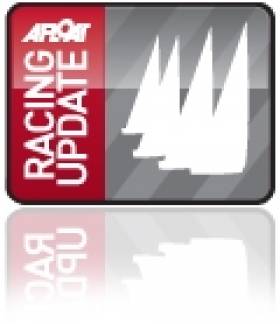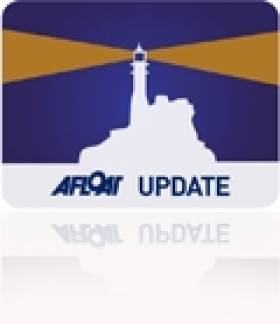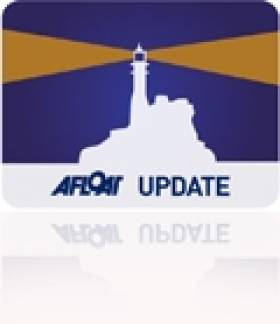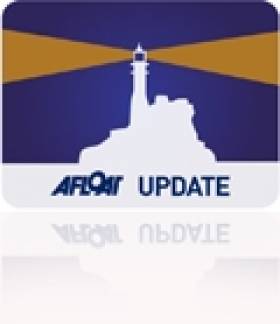Displaying items by tag: Fastnet
Ian Moore Reports in from Phaedo (Great Vid Here)
On board Team Phaedo after a fantastic start to the race, navigator, Ireland's Ian Moore, is happy with their current position.
He made contact last night at 9pm.
"....The sunset is beginning and we are very happy with our position.. we had a great start, picked good shifts, tidal flows and gained well on our exit out of the solent.. The open 60's are with us now and we can see Rambler coming up from behind at pace.
We are very much ahead of where we expected to be at this point.. Over night the breeze will lighten but we hope it will hold and are looking forward to a really good race..."
We will catch them again at the fastnet rock.
Here's a great Phaedo start video from Richard Langdon, the well known British sailing stills photographer who's handling moving pictures pretty well too these days!
Three Volvo 70s Start the Fastnet Race (Pics here)
One of the most impressive sailing sights from the weekend was on the Solent yesterday when three Volvo Ocean Race 2011-12 entries Groupama Sailing Team, Abu Dhabi Ocean Racing and current leader Team Sanya started the Rolex Fastnet Race, the first full blooded test of the boats in the build up to October's start. Ireland has a sponsorship tie in with the Sanya entry and it also has an Irish media man onboard.
Racing Round up: Olympic, Fastnet, Clipper, Figaro, Dragon, J24, Fifteen, Topper, Feva, Oppy
This morning's edition includes photos and pics from Sunday's Figaro departure from Dun Laoghaire and the Rick Tomlinson's pics of the start of the Fastnet race from Cowes. Derry-Londonderry is on her way to Rio in the Clipper race. Regrettably there was no Gold, Silver or Bronze from Weymouth but we're in a strong position. See our video with Annalise here. Plus: The Topper Worlds at the National YC, John Lavery's win at the Flying fifteen South coast champs in Dunmore East, the J24 Nationals from Lough Erne, A local pair whitewashed the RS Feva Nationals in Cork Harbour, some great shots from Bob Bateman. The Oppy Nationals start in Howth and Afloat's Sailor of the Month for July Martin Byrne retained the Dragon Nationals in Kinsale. There's also the full weekend results from Dublin Bay SC.
Largest Ever Fleet Start the Fastnet Race (Photos here)
In the end there were 314 starters, the largest fleet ever to start the Rolex Fastnet Race following the previous record of 303 in 1979.
The first start at 1100 BST saw the giant multihulls heading off. Fastest out of the blocks were Gitana 11 (FRA), the 23.5m trimaran skippered by Vendee Globe and Volvo Ocean Race skipper Sebastien Josse and Roland Jourdain's MOD70 Veolia Environnement (FRA). With round the world yachtswoman Dee Caffari manning her aft grinders, Veolia's sistership, Steve Ravussin's Race For Water (SUI), was over the line early and had to restart.
Visible from most parts of the Solent with her 40 meter long hulls and 47 meter tall mast, the world's fastest offshore boat, the Loick Peyron-skippered Maxi Banque Populaire (FRA) trimaran, thundered across the line and had reached the Needles within an hour, sailing upwind at more than 20 knots. Five hours after starting, Banque Populaire was already approaching Start Point, close to 100 miles down the southwest coast from the start.
Next up were the IMOCA 60 monohulls, and by the Needles, Marc Guillemot -- Yann Elies doublehander Safran (FRA), were leading the newer generation boats.
The ebb tide was beginning to kick in by the time the Class 40s started and most chose to hug the island shore in the most favourable current. By the time they reached the Needles, Tanguy de la Motte's 2009 Rolex Fastnet Race winner, Initiatives-Alex Olivier (FRA), was a nose ahead of the two Kiwi 40s, Roaring Forty 2 (BEL) and Peraspera (ITA). Shortly after passing through Hurst Narrows there was disaster for the Italian entry, Eutourist Serv-System, when she dismasted.
The wind against tide conditions, that were particularly severe at Hurst Narrows at the western entrance to the Solent, would subsequently take their toll on the 43-foot trimaran, Strontium Dog (GBR), that also suffered a dismasting.
The most impressive display were the smaller IRC boats, funnelling their way through Hurst Narrows, and slowly being overhauled by the larger boats that started after. Doing well in IRC 1 was the Ker 46 Tonnerre de Breskens (NED), skippered by veteran sailor Piet Vroon, competing in his 23rd Rolex Fastnet Race.
Prior to leaving Cowes Yacht Haven this morning, Vroon wasn't keen to make many predictions about how this race would unfold. He offered, "A big boat race? It could be an advantage for the bigger boats as they will make Portland and they could get to the Rock before the big wind comes.
"But I don't know. We are bigger than a lot of the small ones! If it is going to be in excess of 30 knots to windward, then it will be hard for the small boats."
Vroon, who won the Rolex Fastnet Race in 2001 said he was expecting to finish sometime on Wednesday morning. "Once we took six days and once we took 68 hours, I believe. So anything in between is good!"
As expected in IRC Zero, the Jim Swartz/Karl Kwok co-skippered Farr 80 Beau Geste (HKG) appeared to be doing well, leading her class through Hurst Narrows ahead of the two silver streaks: Niklas Zennström's 72 foot Ràn (GBR) with Andres Soriano's 68-foot Alegre (GBR) hot on her heels.
Forging their way up the fleet was the intriguing match between the three Volvo Open 70s, due to set off on their round-the-world race this autumn. This is the first time these boats have lined up in anger, and while all three were close as they beat through Hurst Narrows, it was Abu Dhabi Ocean Racing (UAE), skippered by double Olympic silver medallist Ian Walker, that was leading former round-the-world race winner Mike Sanderson on Team Sanya (CHN), with Franck Cammas' Groupama 4 (FRA) bringing up the rear.
There was a hurrah for British sailing fans as the two largest monohulls in the Rolex Fastnet Race fleet thundered up their way up the Solent, with Mike Slade's 100 foot ICAP Leopard (GBR) ahead of the more highly-rated Rambler 100 (USA) of George David. The reason for this was that ten minutes after the gun, Rambler had split her headsail in two and the crew had to scramble to set a replacement.
Before the giant fleet had left the Solent, there were a number of casualties. In addition to the two dismastings, the First 375 Little Spirit (GBR) suffered damage to her forestay during a collision with the Bavaria 44 Emerald Star (GBR) and was forced to retire, as was IRC 3 Howling Monkey (GBR) holed in a collision with the J/109 Jambo! (GBR). The canting-keeled Prodigy (GBR) also retired, with mainsail damage.
Conditions for the bulk of the fleet tonight should be relatively fast, particularly for the smaller boats, which will benefit from the wind veering north of west, as the boats further up the course are set to remain headed.
The main trophy for overall victory in the Rolex Fastnet is the Fastnet Challenge Cup. In addition, there are more than 30 other trophies that will be awarded at the prize giving on Friday, 19 August at the historic Royal Citadel. The Citadel, home to the 29 Commando Regiment Royal Artillery, overlooks Plymouth Sound and Sutton Harbour, where the majority of the fleet will berth.
Record-Breaking Conditions Ahead for Fastnet Race
The largest, most diverse fleet of racing boats ever in offshore yachting set sail this morning in the Rolex Fastnet Race.
The biennial flagship event of the Royal Ocean Racing Club, a tradition since 1925, will take the fleet some 608 miles from Cowes on the Isle of Wight along the UK's south coast and across the Celtc Sea to Fastnet Rock off the Cork coastline, before returning past the Scilly Isles to the finish line at Plymouth.
An incredible 318 yachts are competing this year and they come in all shapes and sizes, from the 40m trimaran Maxi Banque Populaire to the 9.1m Rogers 30, Brightwork.
The majority of the fleet will be racing under the IRC for the Fastnet Challenge Cup, won by the crew that sails best to their rating. The weather will play a big part in this, as a fast start and slow finish favours bigger boats - so far today looks to be the opposite.
The 45-55 foot boats will surely provide the most competitive action, with past Fastnet winner Piet Vroon piloting his championship-leading Ker 46 Tonnere de Breskens towards another victory.
Fans of the Volvo Ocean Race will also be watching the race live tracker intently today, as this is one of the only times many of the competitors will line up together before the start of the round-the-world yachting challenge.
Regatta News has more on the story HERE.
Fastnet Race - Not Just a Record Fleet, it's a Fantastic Fleet
Eddie Warden Owen, Chief Executive of the Royal Ocean Racing Club summed up the quality and quantity of this year's race: "The 2011 Rolex Fastnet Race is not just a record fleet, it is a fantastic fleet from professional high performance racing yachts to family owned production yachts raced by corinthian sailors. The biggest yacht is a 140' Trimaran, Maxi Banque Populaire and the smallest, Brightwork a 30' cruising yacht. It is an amazing array of yachts, quite outstanding."
RORC Commodore, Andrew McIrvine will be racing his First 40, La Réponse and the Commodore has had to qualify for this race just like all of the 300 hundred yachts racing under IRC.
"Besides a large fleet of professional teams racing, there are thousands of sailors competing for the Fastnet Challenge Cup. The Rolex Fastnet Race is a challenge for any of the competitors and this year, the Royal Ocean Racing Club has had a really windy season, so in qualifying for the Race, the competitors are very well prepared. This race was sold out in 11 days back in January. It looks like we are going to have a fantastic race and everybody is really looking forward to it," commented McIrvine.
George David, skipper of Rambler 100, has been enjoying an incredible season, winning the RORC Caribbean 600 overall and taking line honours in last month's Transatlantic Race. The 100' canting keel Maxi is the hot favourite to take line honours for the monohull division, but David is not taking anything for granted: "The weather forecast suggests that we should have wind for the race, there is disagreement about the direction with different forecast models, but it looks as though we should have wind of 12-20 knots, maybe more. We think we could have a shot at the record, but we will see how things go. My main concern when racing is that in order to come first, first you have to finish."
Ross and Campbell Field, the father and son team from New Zealand are both highly accomplished professional sailors, but are new to the Class 40 scene and this will be their
first race together on Hupane. There are over 20 Class 40s in the Rolex Fastnet Race, arguably the most competitive fleet assembled this year.
"I have done a lot of sailing with my Dad and we get on just fine. We are new to the class and we decided to enter this race with a very strong field to see where we are compared to the experienced and successful teams, but we are under no illusions, this is a very good fleet of Class 40s. On board, sometimes I call him Dad, other times Ross, it depends on what message we are trying to get across." said Campbell.
Henry Smith is a squad member of the British Keelboat Academy and will be skippering Yeoman of Wight, which has been loaned to the Academy for young aspiring sailors by former RORC Commodore, David Aisher: "It has always been a personal goal, it is an iconic race and one that I have always wanted to do and this will be my first time. The team on Yeoman are all young, the average age of the crew is 21 and it is very exciting for all of us to be competing, a bit of an Everest really."
In sharp contrast to the young crew on Yeoman of Wight, Ken Newman will be competing in his 27th Fastnet Race in Marinero. Ken reminisced about his first race: "I am in awe sitting here with these supreme sailors. I am glad to be here, but at the age of 82 and a quarter, I am glad to be anywhere! My first Fastnet was in 1957 when 40 boats left Cowes in a gale and by the time we got to Brixham, we had lost both halliards. I had to row ashore to get new blocks which I don't think I paid for. How times have changed since then."
The largest yacht competing in the Rolex Fastnet Race is without doubt the quickest. The 140' Trimaran, Maxi Banque Populaire is skippered by the legendary Loick Peyron and amongst the 14 crew on board is helmsman, Brian Thompson, holder of over 20 world records. "Banque Populaire is capable of reaching and maintaining a speed of nearly 40 knots for several hours. We recently completed a 360 mile race in 12 hours. My dream would be to finish the race with just one night at sea and get in late on Monday night, but the weather may not cooperate. We would like to thank the RORC for allowing big multihulls into the race and add an extra dimension to it. This year, it is an unbelievable fleet, the best Rolex Fastnet Race ever, possibly the best ocean race ever."
The Rolex Fastnet Race starts on Sunday 14th August at 1100 BST. All of the competing yachts will be fitted with the latest tracking systems from Yellowbrick and many of the yachts are capable of sending back messages, pictures and even video of the drama as it unfolds.
Sign up and We'll Send You This Weekend's Irish Sailing News
Monday's edition includes photos and pics from Sunday's Figaro departure from Dun Laoghaire and the start of the Fastnet race from Cowes. Will it be Gold, Silver or Bronze from Weymouth? How will Peter, David and Annalise end up at the Pre-Olympics? Plus: The Topper Worlds at the National YC, Flying fifteen South coast champs in Dunmore East, the J24 Nationals from Lough Erne, Teens battle for the RS Feva Nationals in Cork Harbour, the Cove People's Regatta, The Oppy Nationals at Howth and the Dragon Nationals from Kinsale. There's also the full results from Dublin Bay SC and Howth.
Don't miss your free newsletter. Sign up here.
Safran is One of Six IMOCA 60s to Tackle the Fastnet Race
There have never been as many entrants before for what is one of the world's oldest races. 323 crews will be setting out from the Royal Yacht Squadron in Cowes (Isle of Wight-GB) with a finish in Plymouth after rounding the Irish lighthouse and completing the 608 miles of the race course, in what are often windy conditions. The Fastnet, built in 1854 on the Carraig Aonar, the lone rock in Gaelic, was the final part of the European coast that the emigrants saw as they made their way to the United States in steamers... Organised every other year in odd years by the Royal Ocean Racing Club (RORC), the 2011 Rolex Fastnet Race is the 44th edition of the race, with the record time of 1d 20h 18' held by the monohull ICAL Leopard since 2007...
Time to practice
For Safran which has just completed a training period in La Trinité-sur-Mer after smashing the Round Britain and Ireland record, the Rolex Fastnet Race is above all a taster before the main event of the season, the Transat Jacques Vabre: "The five other IMOCA 60 boats will be racing double-handed, so this is a good way to see how we can do against the latest generation like PRB, Cheminées Poujoulat, Virbac-Paprec3, but also Hugo Boss and DCNS 1000. After our training in La Trinité-sur-Mer, we needed a complete change with a technical course with a range of wind, sea and tidal conditions," explained Marc Guillemot, who arrived on the Isle of Wight on Wednesday.
The 608-mile course tests not only performance capabilities on coastal courses, but also the sailors' abilities in an ocean race. It requires a lot of preparation as well as a good speed potential. "The start is to take place with a North-westerly wind blowing between 10 and 15 knots with squalls likely in the Channel Approaches. In the Celtic Sea, a front should be passing over before the Fastnet Lighthouse and then there are likely to be high-pressure conditions becoming established with an easterly wind accompanying them all the way to the finish in Plymouth. The race will essentially be an upwind affair in moderate winds locally reaching 15-20 knots... They can look forward to at least two days at sea," explained Sylvain Mondon of Météo France.
Finding their feet
Marc Guillemot and Yann Eliès know 60-foot IMOCA boats and double-handed sailing well, having already sailed together in these difficult and sometimes rough seas. That was the case in the Solitaire du Figaro, at the finish or start of transatlantic races and indeed during the Round Britain and Ireland trip. "The Rolex Fastnet Race is a rehearsal for us, a mock exam, a chance to try some double-handed racing. As Safran is a demanding boat and this year's race looks like being rather rough, it means it is going to be similar to what we can expect at the start of the transatlantic race with the exit from the Channel and the voyage across the Bay of Biscay. I raced in this event in 2007 sailing double-handed: it was my first chance to get to know IMOCA 60 sailing and it was an excellent way to rehearse. The course itself is something we know well having taken part in the Solitaire du Figaro: The Fastnet Lighthouse is one of the most beautiful sights from the sea there is in Europe..." explained Yann Eliès.
In the middle of the choppy waters of the Solent, the stretch of water separating the Isle of Wight from the mainland, more than 300 boats will be setting off with a series of starts scheduled from 1200 hrs local time on 14th August. Safran and the five other Imoca 60 boats taking part will quickly be out there with the serious stuff facing the opposition: Marc Guillemot and Yann Eliès will have to find their feet very quickly ...
Moore to Navigate Team Phaedo in Sunday's Fastnet Race
Team Phaedo stayed attached to the dock yesterday, due to high winds and not wanting any unnecessary damage to the boat before Sunday's Race.
They may not have hit the water .. but they ramped up their preparations for the tough offshore challenge of the race ahead of themselves.
The current team on Phaedo for the Fastnet is a serious line up: Owner; Lloyd Thornburg, Captain; Paul Hand, Mate; Nick Crespi, Navigator; Ian Moore, Tactician; Andy Beadsworth, Crew; Ben Bungartz, Jeff Condell, Sam Bason, and Brian Sharp.
Check out the below movie of the boats preparations and the crew onboard:
Virbac-Paprec 3 rising to the challenge of the Fastnet
On Sunday Virbac-Paprec 3 will be lining up for the start of the 44th Rolex Fastnet Race. Jean-Pierre Dick will be assisted by Guillaume Le Brec as he takes on the 608-mile challenge that runs from Cowes to Plymouth via the legendary Fastnet Rock. Of the 350 boats entering the race, six are IMOCA class vessels: Virbac-Paprec 3, Cheminées Poujoulat, DCNS 1000, Hugo Boss, PRB, and Safran. His third Fastnet, Jean-Pierre tells us what's on his mind as he prepares for the starting gun.
"The Rolex Fastnet Race allows us to stay in the game as we get ready for the Transat Jacques Vabre. The IMOCA class is well-represented so it's going to be interesting. We shall be continuing our on-board tests, looking at how the sails behave in close-quarter racing conditions. We're willing to learn and change things if necessary. Conditions in the r ace should be pretty variable so we need to be in top form to handle the boat intelligently and give the race all the energy we've got.
The Rolex Fastnet Race is a legendary race! I've entered twice before and got good results. Second in 2005 and first Frenchman, fifth overall in 1987. I've nothing but great memories."
Why did you choose Guillaume Le Brec for the job of first mate?
"Guillaume sails Mini 6.50s for my team and he's an enormous talent. We've gone over the route, crunched the weather data, and he knows the boat well. He's sailed on her for deliveries and has plenty of experience on IMOCA 60s.
He's the natural choice when Jérémie Beyou, my crew for the Transat Jacques Vabre, is sailing in the Solitaire du Figaro. Jérémie's been doing great in the Figaro, he's currently leading the field! It's a good thing for the project because he's racing all the time."
And what's this about carrying a media man?
"Laurent Simon is responsible for Virbac-Paprec Sailing Team's communication and he'll be sailing with us to get an inside view of the race and send back photos, videos and reports in real time. It's a great opportunity for him to test the new equipment we've had installed. Thanks to Laurent we'll be able to concentrate on the job of sailing."


























